2005 SUBARU FORESTER sensor
[x] Cancel search: sensorPage 64 of 477
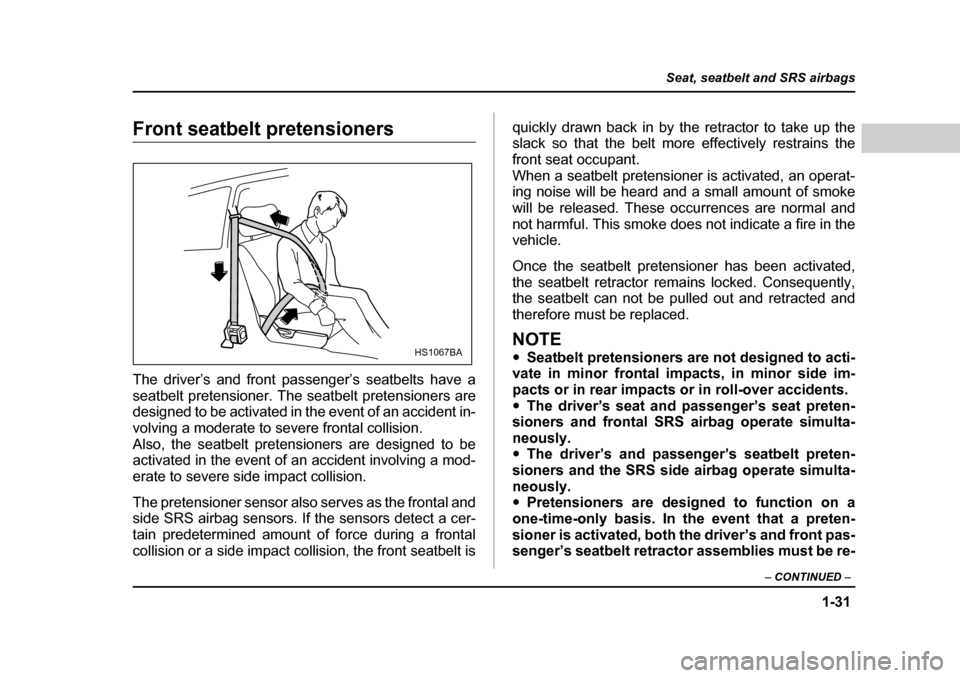
1-31
Seat, seatbelt and SRS airbags
– CONTINUED –
Front seatbelt pretensioners
The driver’s and front passenger’s seatbelts have a
seatbelt pretensioner. The seatbelt pretensioners are
designed to be activated in the event of an accident in-
volving a moderate to severe frontal collision.
Also, the seatbelt pretensioners are designed to be
activated in the event of an accident involving a mod-
erate to severe side impact collision.
The pretensioner sensor also serves as the frontal and
side SRS airbag sensors. If the sensors detect a cer-
tain predetermined amount of force during a frontal
collision or a side impact collision, the front seatbelt is quickly drawn back in by the retractor to take up the
slack so that the belt more effectively restrains the
front seat occupant.
When a seatbelt pretensioner is activated, an operat-
ing noise will be heard and a small amount of smoke
will be released. These occurrences are normal and
not harmful. This smoke does not indicate a fire in the
vehicle.
Once the seatbelt pretensioner has been activated,
the seatbelt retractor remains locked. Consequently,
the seatbelt can not be pulled out and retracted and
therefore must be replaced.
NOTE �y
Seatbelt pretensioners are not designed to acti-
vate in minor frontal impacts, in minor side im-
pacts or in rear impacts or in roll-over accidents. �y The driver’s seat and passenger’s seat preten-
sioners and frontal SRS airbag operate simulta-
neously. �y The driver’s and passenger’s seatbelt preten-
sioners and the SRS side airbag operate simulta-
neously. �y Pretensioners are designed to function on a
one-time-only basis. In the event that a preten- sioner is activated, both the driver’s and front pas-
senger’s seatbelt retractor assemblies must be re-HS1067BA
Page 66 of 477

1-33
Seat, seatbelt and SRS airbags
– CONTINUED –
fore, if any malfunction occurs in a seatbelt preten-
sioner, the SRS airbag system warning light will illumi-
nate. The SRS airbag system warning light will show
normal system operation by lighting for about 6 sec-
onds when the ignition key is turned to the “ON” posi-tion.
The following components are monitored by the indi-
cator:�yFront sub sensor (Right hand side)
�y Front sub sensor (Left hand side)
�y Side airbag sensor (Driver’s side)
�y Side airbag sensor (Passenger’s side)
�y Airbag control module (including impact sensors)
�y Seatbelt pretensioner (Driver’s side)
�y Seatbelt pretensioner (Passenger’s side)
�y All related wiring
�y And all other airbag components
If the warning light exhibits any of the following
conditions, there may be a malfunction in the
seatbelt pretensioners and/or SRS airbag sys-
tem. Immediately take your vehicle to your
nearest SUBARU dealer to have the system
checked. Unless checked and properly re-
paired, the seatbelt pretensioners and/or SRS airbags will operate improperly (e.g. SRS air-
bags may inflate in a very minor collision or not
inflate in a severe collision), which may in-
crease the risk of injury. �y
Flashing or flickering of the indicator light
�y No illumination of the warning light when the
ignition switch is first turned to the “ON” posi-tion�y Continuous illumination of the warning light
�yIllumination of the warning light while driving
�„ System servicing
�yWhen discarding a seatbelt retractor assem-
bly or scrapping the entire vehicle damaged by
a collision, consult your SUBARU dealer. �y Tampering with or disconnecting the sys-
tem’s wiring could result in accidental activa-
tion of the seatbelt pretensioner and/or SRS air-
bag or could make the system inoperative,
which may result in serious injury. The wiring
harnesses of the seatbelt pretensioner and SRS
airbag systems are covered with yellow insula-
tion and the connectors of the system are yel-
Page 67 of 477
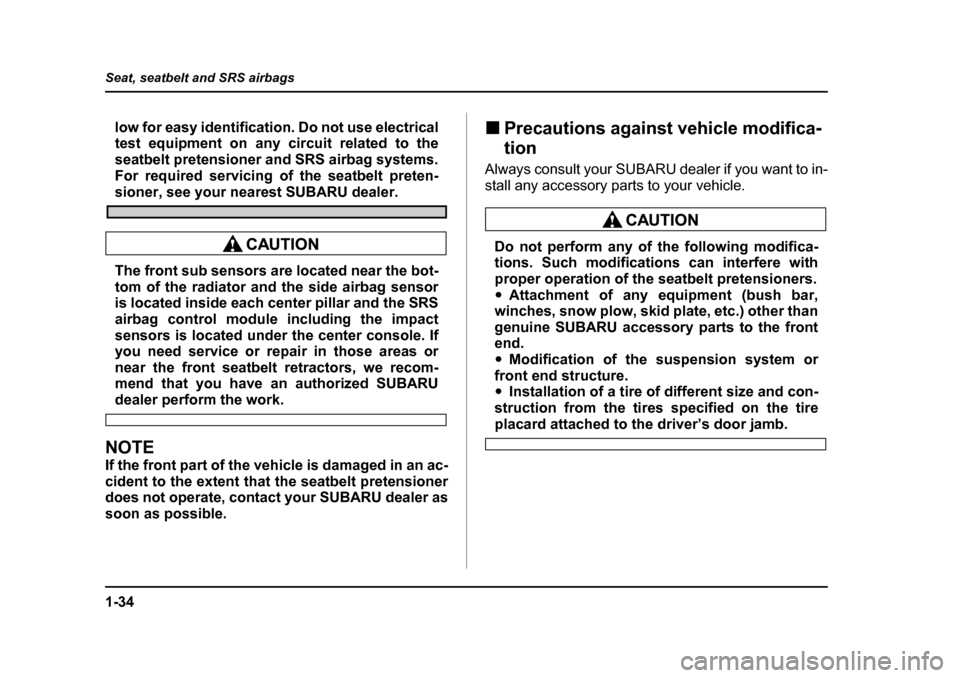
1-34
Seat, seatbelt and SRS airbags
low for easy identification. Do not use electrical
test equipment on any circuit related to the
seatbelt pretensioner and SRS airbag systems.
For required servicing of the seatbelt preten-
sioner, see your nearest SUBARU dealer.
The front sub sensors are located near the bot-
tom of the radiator and the side airbag sensor
is located inside each center pillar and the SRS
airbag control module including the impact
sensors is located under the center console. If
you need service or repair in those areas or
near the front seatbelt retractors, we recom-
mend that you have an authorized SUBARU
dealer perform the work.
NOTE
If the front part of the vehicle is damaged in an ac-
cident to the extent that the seatbelt pretensioner
does not operate, contact your SUBARU dealer as
soon as possible.
�„
Precautions against vehicle modifica- tion
Always consult your SUBARU dealer if you want to in-
stall any accessory parts to your vehicle.
Do not perform any of the following modifica-
tions. Such modifications can interfere with
proper operation of the seatbelt pretensioners.�y Attachment of any equipment (bush bar,
winches, snow plow, skid plate, etc.) other than
genuine SUBARU accessory parts to the front
end. �y Modification of the suspension system or
front end structure. �y Installation of a tire of different size and con-
struction from the tires specified on the tire
placard attached to the driver’s door jamb.
Page 89 of 477
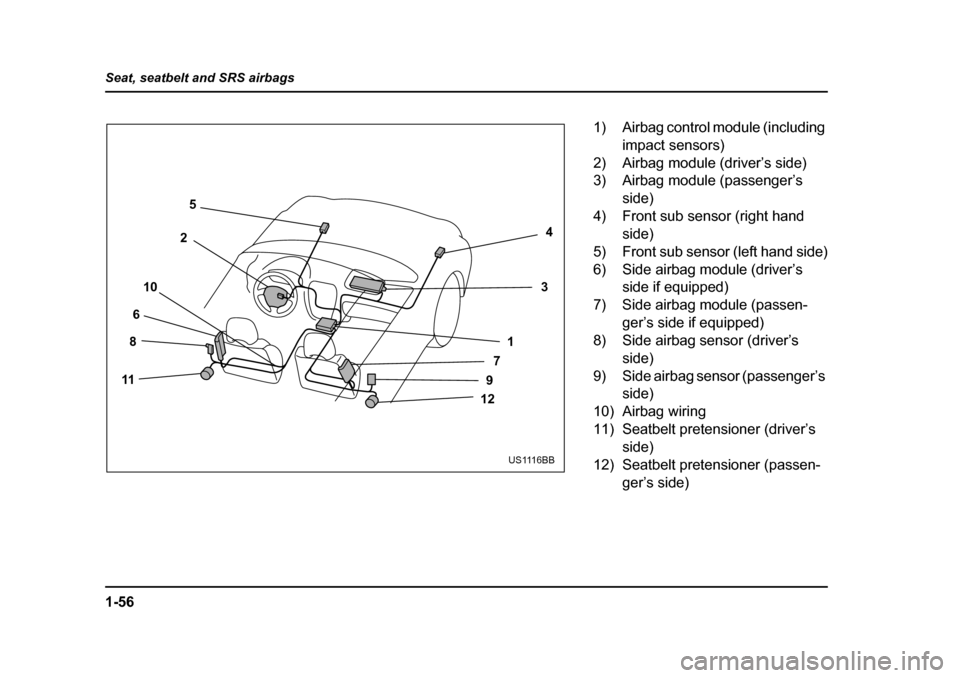
1-56
Seat, seatbelt and SRS airbags
4
3
1
7
9
12
5
2
10
6
8
11
US1116BB
1) Airbag control module (including impact sensors)
2) Airbag module (driver’s side)
3) Airbag module (passenger’s
side)
4) Front sub sensor (right hand
side)
5) Front sub sensor (left hand side)
6) Side airbag module (driver’s side if equipped)
7) Side airbag module (passen- ger’s side if equipped)
8) Side airbag sensor (driver’s
side)
9) Side airbag sensor (passenger’s side)
10) Airbag wiring
11) Seatbelt pretensioner (driver’s side)
12) Seatbelt pretensioner (passen- ger’s side)
Page 94 of 477
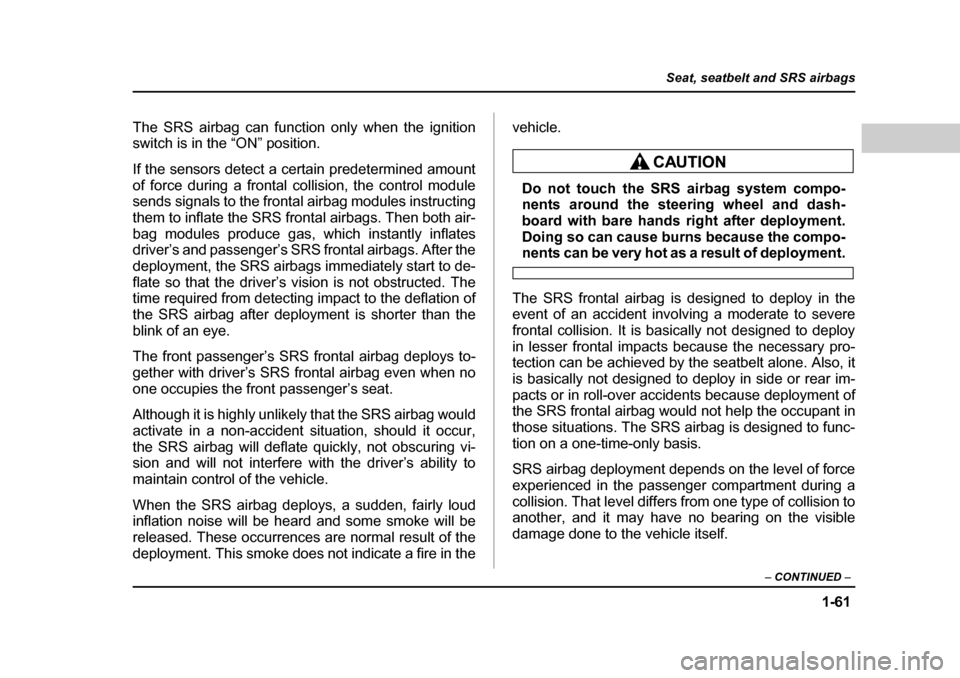
1-61
Seat, seatbelt and SRS airbags
– CONTINUED –
The SRS airbag can function only when the ignition
switch is in the “ON” position.
If the sensors detect a certain predetermined amount
of force during a frontal collision, the control module
sends signals to the frontal airbag modules instructing
them to inflate the SRS frontal airbags. Then both air-
bag modules produce gas, which instantly inflates
driver’s and passenger’s SRS frontal airbags. After the
deployment, the SRS airbags immediately start to de-
flate so that the driver’s vision is not obstructed. The
time required from detecting impact to the deflation of
the SRS airbag after deployment is shorter than the
blink of an eye.
The front passenger’s SRS frontal airbag deploys to-
gether with driver’s SRS frontal airbag even when no
one occupies the front passenger’s seat.
Although it is highly unlikely that the SRS airbag would
activate in a non-accident situation, should it occur,
the SRS airbag will deflate quickly, not obscuring vi-
sion and will not interfere with the driver’s ability to
maintain control of the vehicle.
When the SRS airbag deploys, a sudden, fairly loud
inflation noise will be heard and some smoke will be
released. These occurrences are normal result of the
deployment. This smoke does not indicate a fire in the vehicle.
Do not touch the SRS airbag system compo-
nents around the steering wheel and dash-
board with bare hands right after deployment.
Doing so can cause burns because the compo-
nents can be very hot as a result of deployment.
The SRS frontal airbag is designed to deploy in the
event of an accident involving a moderate to severe
frontal collision. It is basically not designed to deploy
in lesser frontal impacts because the necessary pro-
tection can be achieved by the seatbelt alone. Also, it
is basically not designed to deploy in side or rear im-
pacts or in roll-over accidents because deployment of
the SRS frontal airbag would not help the occupant in
those situations. The SRS airbag is designed to func-
tion on a one-time-only basis.
SRS airbag deployment depends on the level of force
experienced in the passenger compartment during a
collision. That level differs from one type of collision to
another, and it may have no bearing on the visible
damage done to the vehicle itself.
Page 102 of 477
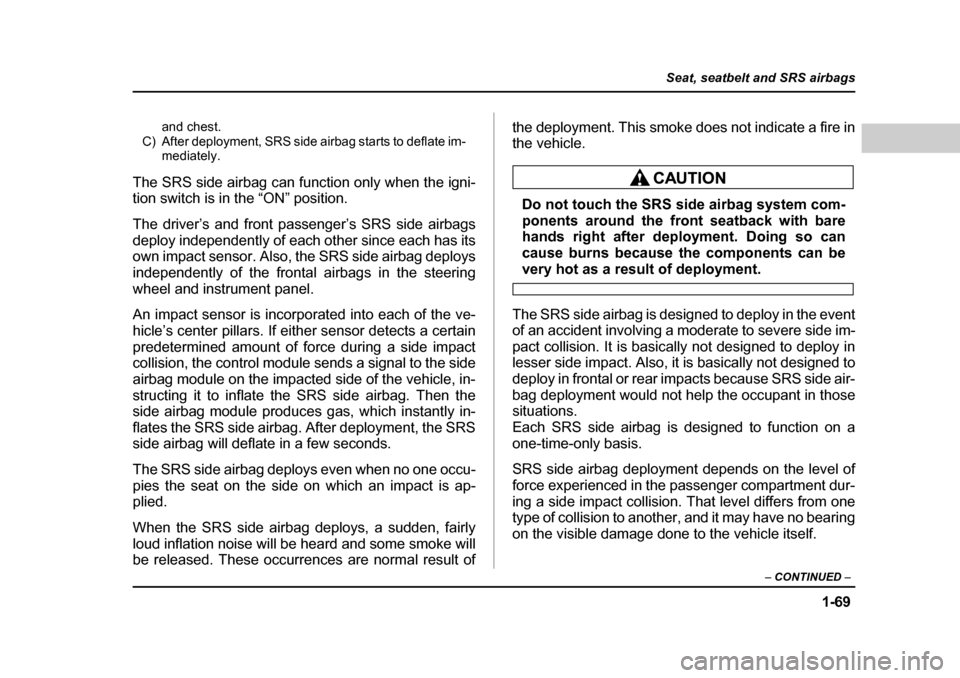
1-69
Seat, seatbelt and SRS airbags
– CONTINUED –
and chest.
C) After deployment, SRS side airbag starts to deflate im- mediately.
The SRS side airbag can function only when the igni-
tion switch is in the “ON” position.
The driver’s and front passenger’s SRS side airbags
deploy independently of each other since each has its
own impact sensor. Also, the SRS side airbag deploys
independently of the frontal airbags in the steering
wheel and instrument panel.
An impact sensor is incorporated into each of the ve-
hicle’s center pillars. If either sensor detects a certain
predetermined amount of force during a side impact
collision, the control module sends a signal to the side
airbag module on the impacted side of the vehicle, in-
structing it to inflate the SRS side airbag. Then the
side airbag module produces gas, which instantly in-
flates the SRS side airbag. After deployment, the SRS
side airbag will deflate in a few seconds.
The SRS side airbag deploys even when no one occu-
pies the seat on the side on which an impact is ap-
plied.
When the SRS side airbag deploys, a sudden, fairly
loud inflation noise will be heard and some smoke will
be released. These occurrences are normal result of the deployment. This smoke does not indicate a fire in
the vehicle.
Do not touch the SRS side airbag system com-
ponents around the front seatback with bare
hands right after deployment. Doing so can
cause burns because the components can be
very hot as a result of deployment.
The SRS side airbag is designed to deploy in the event
of an accident involving a moderate to severe side im-
pact collision. It is basically not designed to deploy in
lesser side impact. Also, it is basically not designed to
deploy in frontal or rear impacts because SRS side air-
bag deployment would not help the occupant in those
situations.
Each SRS side airbag is designed to function on a
one-time-only basis.
SRS side airbag deployment depends on the level of
force experienced in the passenger compartment dur-
ing a side impact collision. That level differs from one
type of collision to another, and it may have no bearing
on the visible damage done to the vehicle itself.
Page 106 of 477

1-73
Seat, seatbelt and SRS airbags
– CONTINUED –
The SRS side airbag is basically not designed to de-
ploy if the vehicle is involved in a frontal collision or is
struck from behind. Examples of such accidents are il-
lustrated.
A) First impact
B) Second impact
In an accident where the vehicle is struck from the side
more than once, the SRS side airbag deploys only once.
Example: In the case of a double side impact collision,
first with one vehicle and immediately followed by an-
other from the same direction, once the SRS side air-
bag is activated on the first impact, it will not be acti- vated on the second. �„
SRS airbag system monitors
A diagnostic system continually monitors the readi-
ness of the SRS airbag system while the vehicle is be-
ing driven. The SRS airbag system warning light “AIR-
BAG” will show normal system operation by lighting for
about 6 seconds when the ignition key is turned to the
“ON” position.
The following components are monitored by the indi- cator: �y Front sub sensor (Right hand side)
�y Front sub sensor (Left hand side)
B
A
HS1102BCUS1115BA
Page 107 of 477
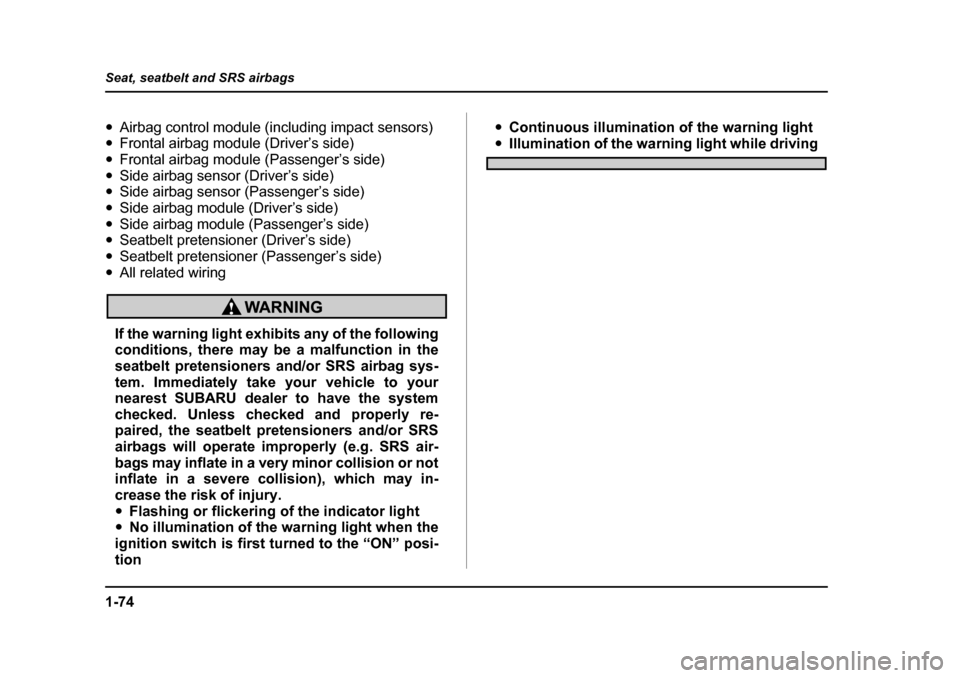
1-74
Seat, seatbelt and SRS airbags
�y
Airbag control module (including impact sensors)
�y Frontal airbag module (Driver’s side)
�y Frontal airbag module (Passenger’s side)
�y Side airbag sensor (Driver’s side)
�y Side airbag sensor (Passenger’s side)
�y Side airbag module (Driver’s side)
�y Side airbag module (Passenger’s side)
�y Seatbelt pretensioner (Driver’s side)
�y Seatbelt pretensioner (Passenger’s side)
�y All related wiring
If the warning light exhibits any of the following
conditions, there may be a malfunction in the
seatbelt pretensioners and/or SRS airbag sys-
tem. Immediately take your vehicle to your
nearest SUBARU dealer to have the system
checked. Unless checked and properly re-
paired, the seatbelt pretensioners and/or SRS
airbags will operate improperly (e.g. SRS air-
bags may inflate in a very minor collision or not
inflate in a severe collision), which may in-
crease the risk of injury. �yFlashing or flickering of the indicator light
�y No illumination of the warning light when the
ignition switch is first turned to the “ON” posi-tion �y
Continuous illumination of the warning light
�yIllumination of the warning light while driving